Email best practices
Email marketing objectives: 10 ways it can boost your business
The objectives of email marketing vary from business to business. So, how do you know if you’re using email in the most effective ways? Discover 10 of the biggest email marketing objectives to help you understand how your business can take advantage of an essential communication channel.
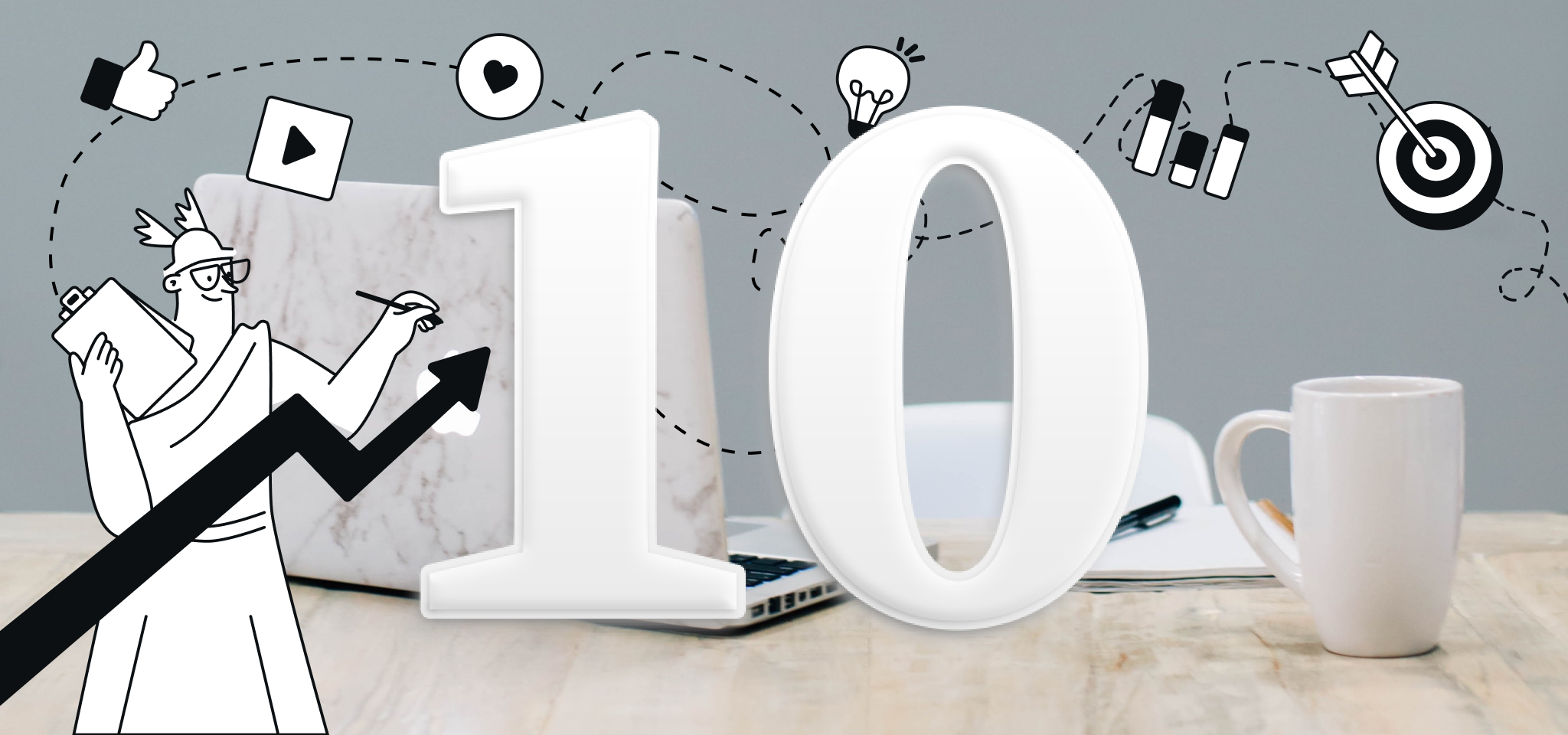
PUBLISHED ON
What can email marketing do for you and your business? Seriously... What’s the point of sending emails anyway?
We could talk all day about the value of reaching people through email communications. But why take our word for it? Let’s explore the many ways you can use email marketing to reach people, serve customers, spread ideas, and grow your business.
You’ll find that email is an indispensable part of running a business in the digital age. Here’s how to take advantage of the ways email marketing provides support, improves efficiency, and drives growth – no matter what kind of business you’re running.
Table of contents
1. Distributing marketing content
2. Sending transactional communications
3. Promoting and selling products and services
4. Providing product updates and company news
5. Nurturing leads and prospects
6. Retaining customers and generating loyalty
7. Onboarding and welcoming newcomers
8. Driving traffic to your website
9. Communicating with customer support
10. Re-engaging and reactivating inactive subscribers
Why do you need email marketing goals and objectives?
If you plan to send marketing emails just because it’s what you’re supposed to do, step back and think about the reasons why your business should put forth the time and effort.
A lot of brands fall into the trap of chasing the hottest social media channel or assuming the latest marketing trend is the answer to all their problems. Even though email is one of the original digital marketing channels, you can still waste time on flashy efforts that don’t serve your business or your customers.
To use email strategically, the first thing you should do is identify the problems email communication can help you solve. Those problems will point you toward the right email objectives. Here are three examples:
When not enough people are viewing your company’s blog content, an email newsletter could help increase interest.
If you experience seasonal sales slowdowns, email promotions could boost revenue.
Are new users abandoning your product after a trial period? Educate them and show the product’s value with onboarding emails that convince them to stick around.
Once you have your objectives, you can set specific email marketing goals and choose metrics to track so you are able to measure your success. That includes a better understanding of email’s return on investment (ROI).
The top 10 email marketing objectives
So, what’s the best use of email marketing for your business? Even though every company is unique, there’s a lot to be learned from the strategies of senders who’ve been doing it for years. Thankfully, you don’t have to ask them about their thoughts on email marketing objectives, because we already did.
You can use these findings to determine the most effective use cases for your email marketing program.
Sinch Mailjet surveyed more than 3,000 senders to compile our comprehensive report, Inbox Insights 2023. In this article, however, we’re going to focus on one big question:
What are the most important objectives that email helps your company achieve?
Because email serves so many different business objectives, Inbox Insights respondents could select up to three options. The results show there’s quite a spread among what marketers believe are the most important uses for email.
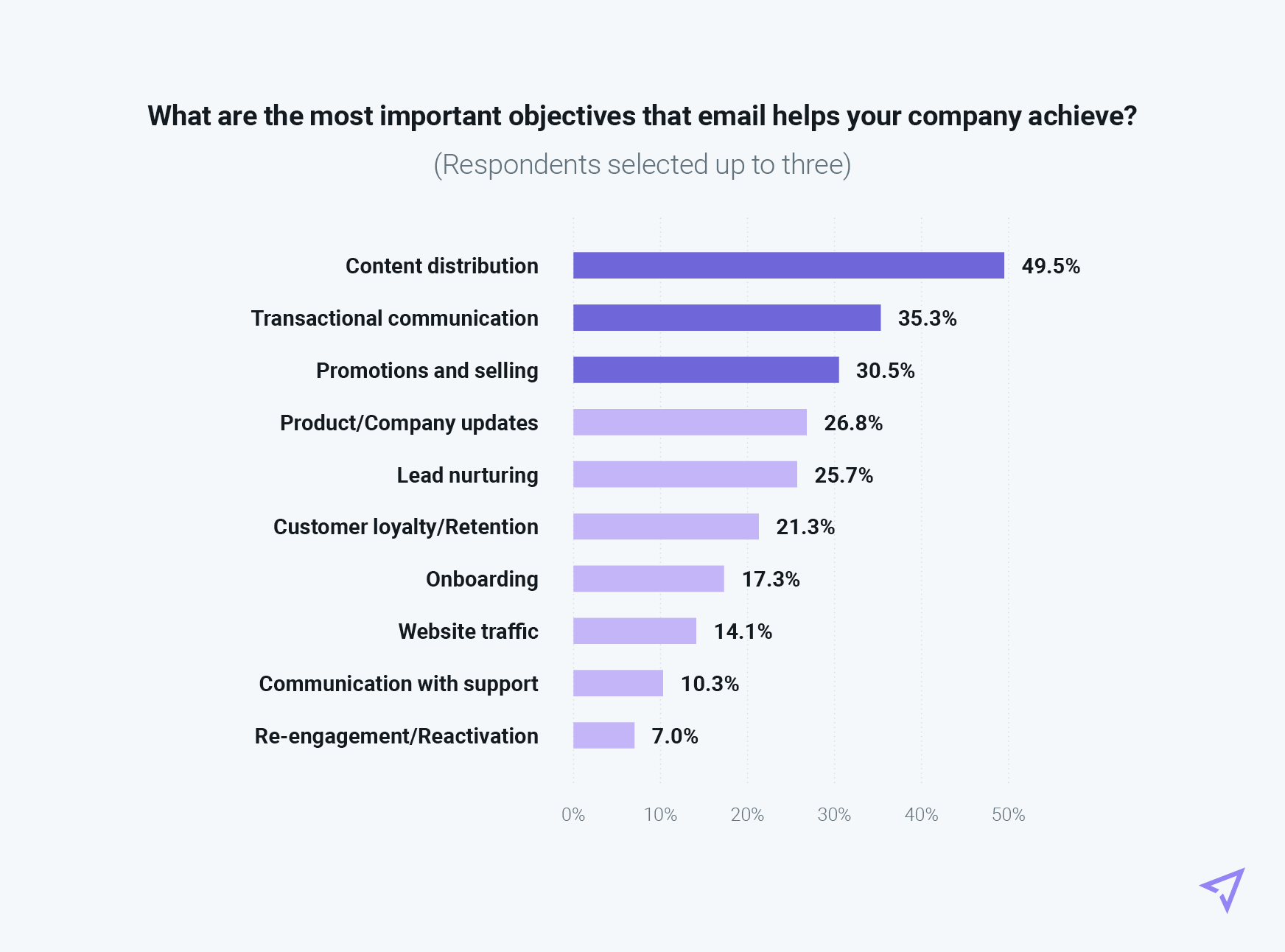
Even the email marketing objectives that landed lower on the list could be extremely important to those businesses (and maybe yours too). So, let’s dig into each of these 10 objectives and discover how you can use the email communication channel to its fullest potential.
1. Distributing marketing content
The term “content” is pretty vague. But when we use it in marketing terms, we mean articles, videos, podcasts, infographics, reports, case studies, testimonials, informational landing pages, and anything else your business creates and publishes online. That’s content marketing.
Email and content marketing go hand-in-hand. Email marketers need good content that keeps subscribers interested and engaged. Content marketers need email to get their stuff in front of the right audience. So, email is an essential part of a successful content marketing strategy.
In our survey, Content distribution topped the list of what email is expected to achieve. Nearly 50% of respondents called it a top email marketing objective in their company. The most common way to distribute content to inboxes is through sending regular email newsletters.
You can put whatever you want in an email newsletter. The key is to consistently deliver something valuable. That means knowing your target audience so you can distribute content that is timely and relevant. Here’s part of an email newsletter from Sinch Email on Acid.

If your company is blogging regularly, the objective of your newsletter may be to distribute those articles. But your newsletter could also contain curated content from other websites. Or you could feature exclusive email content for subscribers only.
The primary objective of using an email newsletter for content distribution should be to educate, inform, and even entertain your subscribers. This doesn’t mean you should never use a newsletter for promotional purposes. But if that’s the sole purpose, people will eventually get annoyed and unsubscribe.
Watch your stats to see what kinds of content resonate with your list. This can help you identify what to create and deliver next. An excellent benefit of distributing content via email is learning about what matters most to customers and prospects.
No matter what you distribute via email, your goal is to have subscribers anticipating the next thing to hit their inboxes – because they know there’s good content inside.
2. Sending transactional communications
Some of the most important messages a business sends aren’t marketing emails at all. That’s probably why Transactional communication (35.3%) was the second most-cited email objective in our survey.
Transactional emails include everything from order confirmations and invoices to shipping updates and password resets. They can also confirm reservations or deliver digital products. Whether you’re running an ecommerce store, a restaurant, or selling software, these are very important customer communications that people expect to receive.
As marketers, it’s easy to take transactional emails for granted. They’re automated, they usually happen after the sale, and they can be kind of boring. But transactional communication is a huge part of the customer experience. In fact, Mailjet found that 93% of consumers would consider switching brands after a bad experience with transactional email.
Check out the transactional message from Squarespace below that notifies a potential customer about the end of their free trial. It’s basic, but it has a clear objective: Illustrate the benefits of the service and create a sense of urgency so that the trial user decides to become a paying customer.
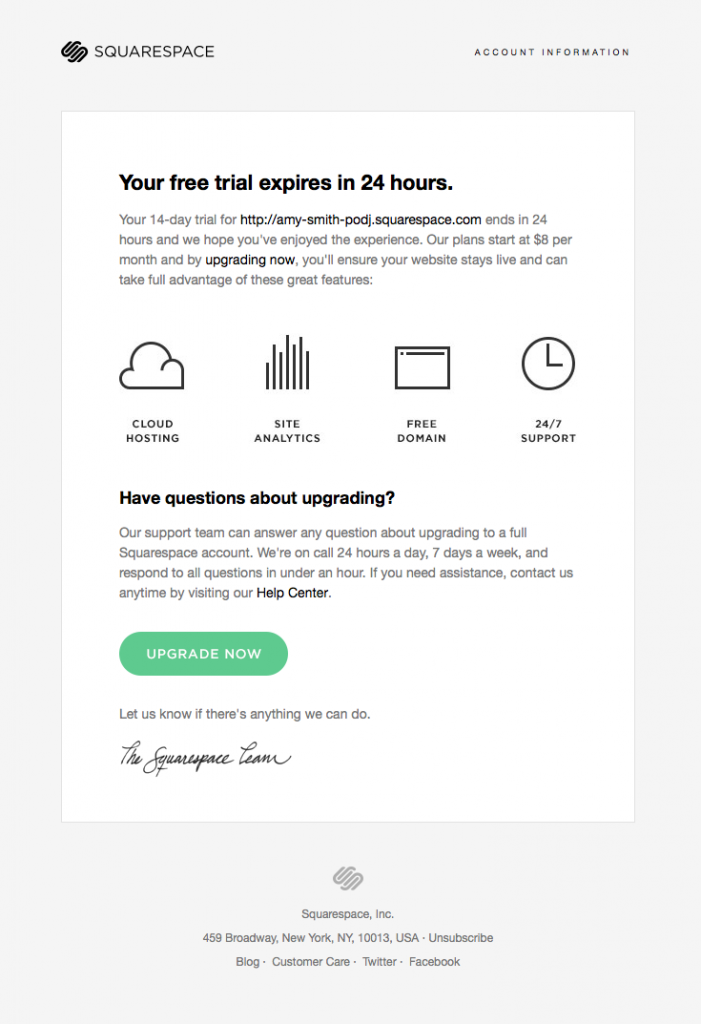
By making transactional emails a top objective, you’re focusing on building customer satisfaction and trust through clear and timely communication. As an added bonus, transactional emails also help your business run more efficiently. After you start automating these kinds of communications, you may notice fewer calls to customer support and more positive online reviews.
The truth is, even the simplest transactional messages are part of your business’s marketing strategy. Because, as Silicon Vally marketing legend Regis McKenna said back in the early ‘90s, “everything is marketing.”
“... the critical dimensions of the company – including all of the attributes that together define how the company does business – are ultimately the functions of marketing. That is why marketing is everyone’s job, why marketing is everything and everything is marketing.”
Regis McKenna, Harvard Business Review, 1991
3. Promoting and selling products and services
When most people think of marketing emails, they imagine the messages that land in their Gmail Promotions tab. These marketing campaigns pitch products, come with coupon codes, and often feature eye-catching email design.
It’s true... Email is an excellent channel for direct response marketing. Our survey found that more than 30% of senders view Promotions and selling as one of their top three email marketing objectives.
Beyond content distribution and straightforward transactional communication, businesses expect email to help generate sales and revenue. In many cases, your customers want to receive your promotions. It may even be the reason they subscribed in the first place. The tricky part is sending the right email promotions to the right people at the right time.
Promotional campaigns will be more relevant, and you’ll see a higher conversion rate when you start using email segmentation. If you split up your contact list into segments, you can craft specialized promotions for people with different interests, lifestyles, locations, or other factors.
Take things even further when you send personalized promotional emails. You can start by using your subscribers’ names in subject lines and copy. However, Inbox Insights 2023 found that most respondents using personalization already do that.
To stand out and increase engagement, try personalized product recommendations based on past purchases in your promotional emails. Netflix uses this sort of personalization strategy based on shows its subscribers have streamed.

Just like content, assessing email engagement from promotional campaigns can provide you with super valuable information about customers and prospects. Look for the campaigns that resonate the most, the deals that drive conversions, and the product categories that generate interest. These things not only guide your email strategy, but they can inform the overall business strategy too.
4. Providing product updates and company news
When you’ve got something new and exciting to share, one of the best ways to get the word out is with an email. Nearly 27% of the senders we surveyed think Product/Company updates are among the most important email marketing objectives.
Product marketers rely on email almost as much as content marketers. That’s because email offers a direct channel to the people who matter most – customers and prospects. An email campaign about a new feature could convince an existing customer to upgrade or persuade a prospect to make a purchase.
Here’s an email example from the skin care brand, Dermatica, which promotes new formulations for its products.
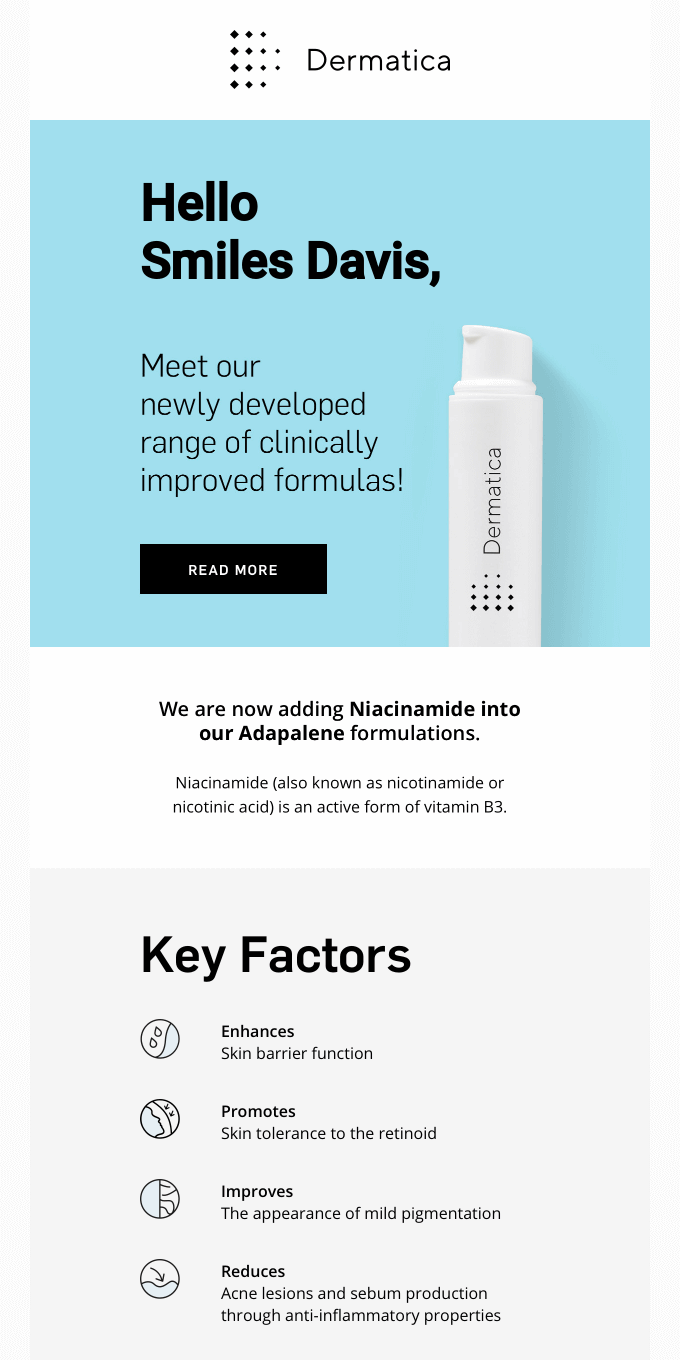
In addition to product launches and enhancements, you can use email to deliver company news. Just make sure you make that news relevant to your subscribers. Don’t just talk about yourself. Explain why updates about your business matter to them.
5. Nurturing leads and prospects
A customer may be an email subscriber, but not all your subscribers are customers. At least not yet.
You may not have a complex lead scoring system of marketing qualified leads (MQLs) and sales qualified leads (SQLs). But nearly every email list has plenty of contacts who can be transformed into paying customers with a little nurturing.
An email nurture series is designed to convert leads into customers. These automated campaigns are usually delivered to a segment of recipients who’ve shown a specific interest in your company. Maybe they filled out a form on a certain landing page, attended a webinar, or asked for information on a product or service.
That specific interest informs the content of your email nurture series. Each message in the nurture track delivers value, answering questions, addressing pain points, and providing helpful resources. The email series guides their decision-making process.
The email below from NerdWallet could come at the end of a nurture series that delivered helpful personal finance advice to the prospect. Now, the sender is presenting a solution to help make managing finances easier.

Maybe the contacts in this nurture series first downloaded an ebook from NerdWallet. Or perhaps they filled out a form when comparing credit cards. Now that marketers know what matters to these subscribers, an email series addressing their interests and concerns makes the inbox experience relevant and helpful. And people are more likely to do business with brands that provide help and expertise.
6. Retaining customers and generating loyalty
The customer journey is far from over when a prospect makes a purchase. So, don’t forget about those people. Email is the perfect communication channel for keeping customer relationships alive.
Sending consistent emails can reduce customer churn, and more than 21% of senders in the Inbox Insights 2023 survey call that a top objective of email marketing. By staying in communication with customers, you show you care about their success and satisfaction. They’re less likely to leave you for a competitor, and more likely to be repeat buyers.
For some marketing teams, it helps to think of your content and emails as extensions of your products and services. It’s not just marketing, it’s part of the customer experience.
Here’s an email showing how Miro keeps customers engaged with its product:

Notice how there’s a benefit in the email’s headline: “Become more productive.” Then the campaign delivers on that promise by presenting a series of tips to help customers get the most out of using Miro. This ensures Miro users understand the full value of their purchase decision, so they keep using the product and keep renewing their subscriptions.
7. Onboarding and welcoming newcomers
If you want new customers to stick around, make sure you do whatever you can to start the relationship off on the right foot. When someone signs up for a trial, makes an initial purchase, or simply subscribes, they should get an email almost immediately.
Otherwise, those new folks will feel like they walked into a party all alone, and everyone there ignored them. That’s not cool.
Onboarding emails welcome newcomers, allow them to get to know your brand, and set them up for success. While 17.3% of our survey participants chose Onboarding as one of their top email marketing objectives, Lifecycle marketing specialists think it’s even more important. More than 30% of respondents who are focused on the customer lifecycle say onboarding emails are a priority.
Onboarding emails are somewhat synonymous with the welcome email series. While the customer onboarding process for some technical B2B software may include informational training material, even the simplest B2C brands will benefit from delivering an enthusiastic welcome to a new customer’s inbox.
Here’s an excellent welcome email from Adobe Lightroom. Notice how it welcomes the subscriber into a new community while suggesting ways to use the product as part of that community and showcasing photographs that will resonate with the target audience.

8. Driving traffic to your website
Take a look at your website analytics on the days you send out newsletters and promotions. You’re sure to see a significant spike in traffic. Just over 14% of senders say generating Website traffic is a top email objective.
While organic search traffic from sources like Google likely deliver the bulk of traffic to your site, there’s something special about email traffic. These people tend to be further along in the customer journey. They’re not just stopping by for a quick visit.
Your subscribers are already familiar with your brand and what you have to offer. They expressed serious interest in your company when they signed up for emails. Convincing them to click through to something like an article often leads to them checking out more on the website. That could result in them taking other positive actions, like making a purchase, upgrading their plan, or sharing your content on social media.
Email marketing traffic includes people who’ve progressed further in the path to purchase. They’re familiar with your brand and closer to making a decision.
Just remember, website traffic for the sake of traffic is pretty pointless. What you really want to know is what happens when email recipients visit your site. To get that information, you’ll need to look beyond the stats in your ESP. What happens after they click a link in your campaign? How do subscribers behave once they’re on your website?
Think carefully about where you send email subscribers. Will they get value out of clicking through, or will they be disappointed when they reach your landing page? Treat subscribers with respect and only drive email traffic to things that are relevant to them.
9. Communicating with customer support
Sometimes marketers forget that email is a two-way channel. Besides the ability to deliver your messages to subscribers, email serves the purpose of allowing customers and prospects to get help.
More than 10% of survey respondents said Communication with support is a top email marketing objective in their company. When we segment those results to look at IT job roles only, the percentage doubles to more than 21%. IT professionals often need to think about the technicalities of both incoming and outgoing mail. Plus, many of them also know a thing or two about people needing support.
Your customer support team can also help you build your list of subscribers. In our Email Growth Playbook, we suggest having customer support promote your newsletter by encouraging people to sign up and stay informed.
10. Re-engaging and reactivating inactive subscribers
Even though it landed on the bottom of the list of top email marketing objectives, re-engaging inactive subscribers and reactivating dormant customers is important to 7% of survey respondents.
If you ignore re-engagement and reactivation, you could miss out on a major opportunity. Sometimes subscribers need to be reminded of everything your business has to offer. Here’s how GoDaddy uses email marketing to reactivate subscribers using a personalized promo code.
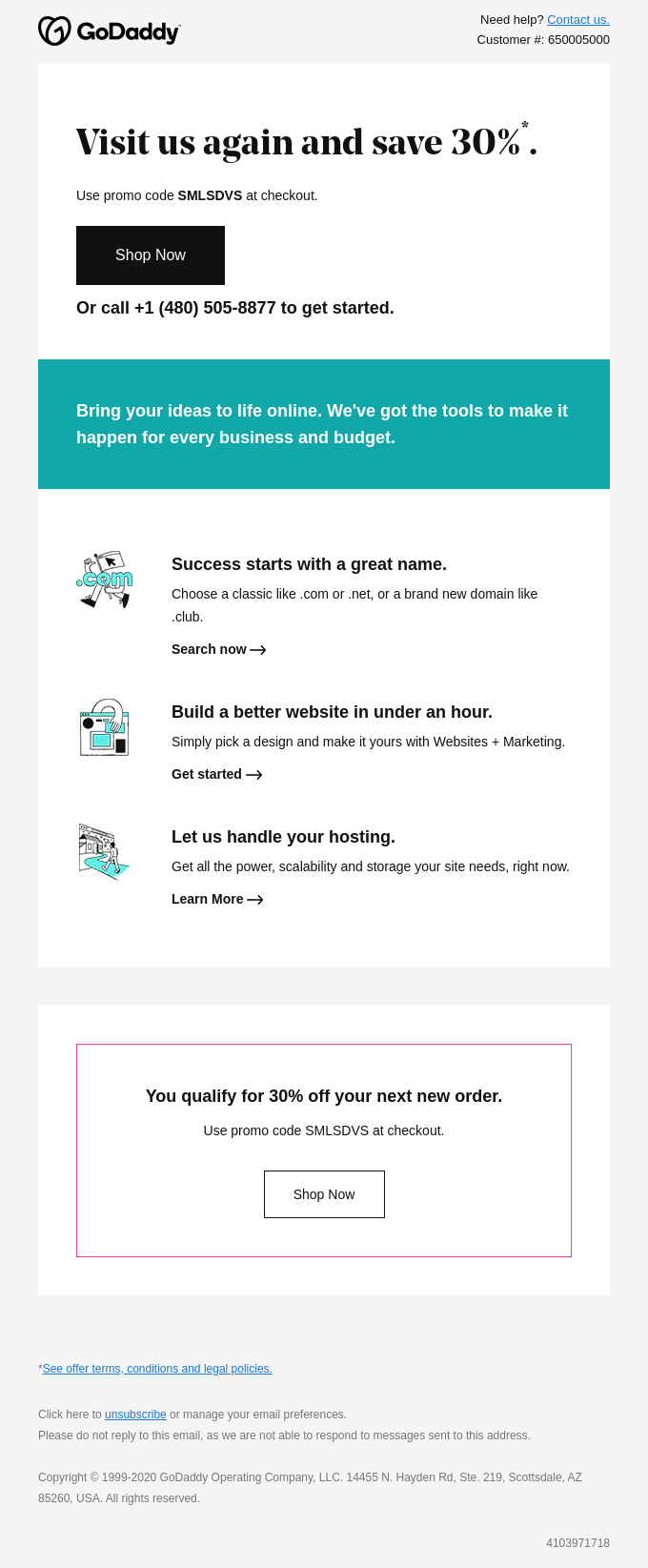
Good email list hygiene includes the process of removing inactive recipients. You want to get rid of those contacts because low email engagement can drag down your reputation with major mailbox providers, which could mean more of your messages land in spam.
However, before you say so long to unengaged subscribers, you can send a re-engagement campaign, asking them to resubscribe if they still want to receive emails from your company.
Set email marketing goals and measure success
The 10 objectives we’ve listed in this article take a high-level approach to email marketing’s capabilities. By that we mean, your email strategy and goals should be more specific. Choose the email marketing objectives that have the potential to boost your business, define the metrics you’ll use to measure success, and set distinct goals you hope to achieve with email. Wondering how to do that? Here are four examples:
When content distribution is the objective, you’ll likely want to evaluate clicks. Are you convincing subscribers to consume content or do they open emails without taking any action?
Note: Go even deeper by measuring website analytics like the time subscribers spend on the site or the number of pages they visit.
For transactional emails, deliverability is a major objective. You could focus on a metric like inbox placement to ensure those important messages stay out of spam.
Note: You may also want to measure open rates of transactional emails to be sure your subject lines are getting noticed.
With promotional emails, you’ll want to measure clicks and conversions. Do your emails make people want to learn more, and how well do subscribers convert on the site?
The effect of onboarding emails can be measured by examining customer retention.
The point is this: Once you choose your top email marketing objectives, think about how you’ll determine what’s working and where you need to improve your efforts.
Find tools that maximize email’s possibilities
The right marketing technology is a solution that supports your efforts to achieve your goals. At Sinch Mailjet, we’ve built an email marketing platform that’s designed to make success easy.
Start with our flexible Form Builder to build your list as you capture leads and contacts.
Develop an onboarding series that welcomes and nurtures new customers and prospects when you take advantage of our built-in Email Automation workflows.
Use our intuitive, drag-and-drop Email Editor to build unique newsletters that distribute your best content in style.
Segment and personalize your promotional campaigns to make marketing emails more engaging and relevant to every individual on your list.
Evaluate your results on the Statistics Dashboard using our email tracking tools.
The best part? Getting started with Sinch Mailjet is free. You can scale up to the Premium plan features as your business grows and you need more. Start sending with Mailjet today and find out how we can help you achieve all your email marketing objectives.








